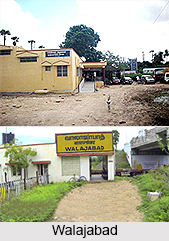 Walajabad is located in Kanchipuram district in the Indian state of Tamil Nadu.
Walajabad is located in Kanchipuram district in the Indian state of Tamil Nadu.
History of Walajabad
Walajabad is a Panchayat town and was earlier known as Sivapuram before the Nawab of Arcot was invaded. Later it was named as Walajabad.
Demography of Walajabad
According to the census report of 2001, Walajabad has a population of 10,859. The males constitute 50 percent of the population and females 50 percent.
Education of Walajabad
The average literacy rate is 75% in Walajabad that is higher than the national average of 59.5%. The male literacy is 82%, and female literacy is 68%. 12% of the population is under 6 years of age in Walajabad. To cater to the educational needs of the town, Walajabad has established many schools and colleges. Some of the major colleges of located here are Lord Venkateswara Engineering College, Pachaiyappas Women`s College, Pachaiyappas Men`s College, Pallavan College of engineering, Lord Iyyappa Engineering College, The Indian Public School and Amirtham College.
Tourism in Walajabad
Walajabad is also famous for pilgrimage locations that were built by the Pallava Rulers of early India. The temples of Walajabad are dedicated to Lord Shiva and Lord Vishnu of the Pallava Dynasty are present here. Sipcot IT Park, The largest Information Technology Park in Asia is located here.
Visiting Information
Walajabad is well connected with all modes of transport. Walajabad links all the major cities like Kanchipuram, Chennai, Chengalpet and Illaiyanaavellur.
This article is a stub. You can enrich by adding more information to it. Send your Write Up to content@indianetzone.com



















